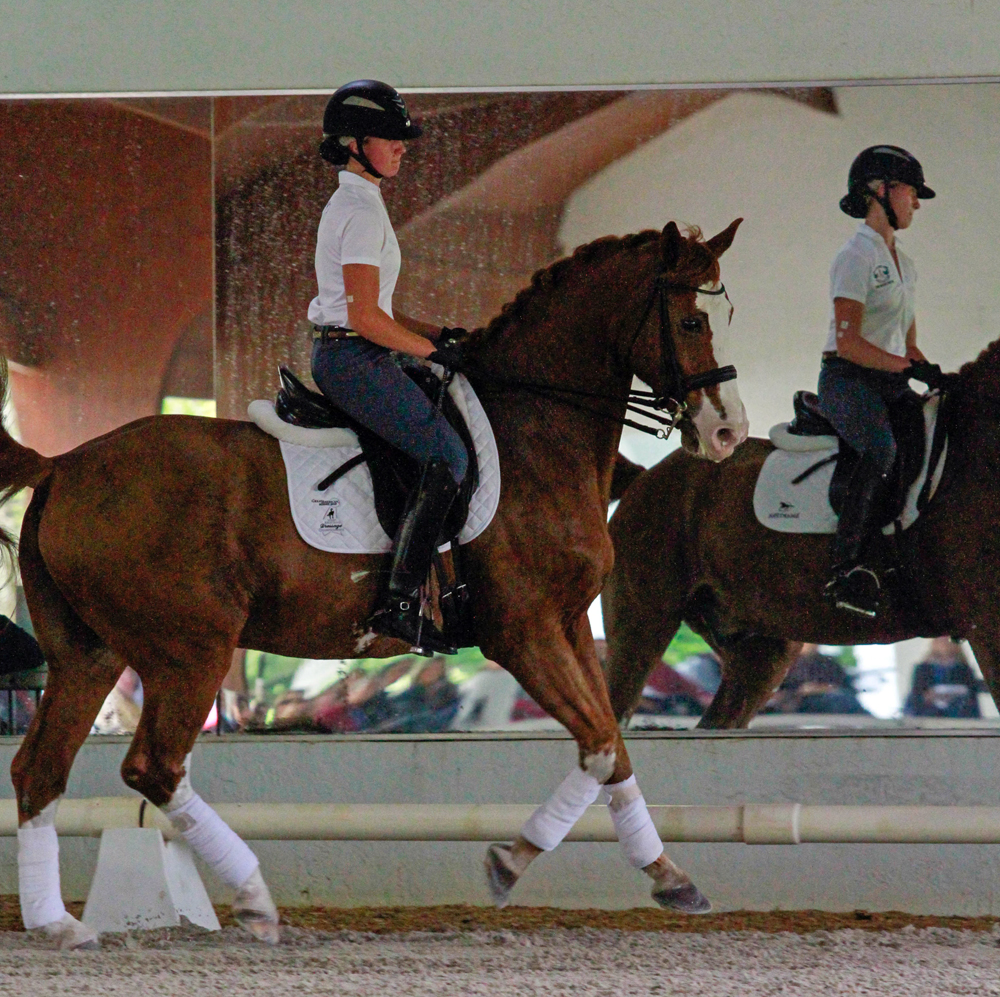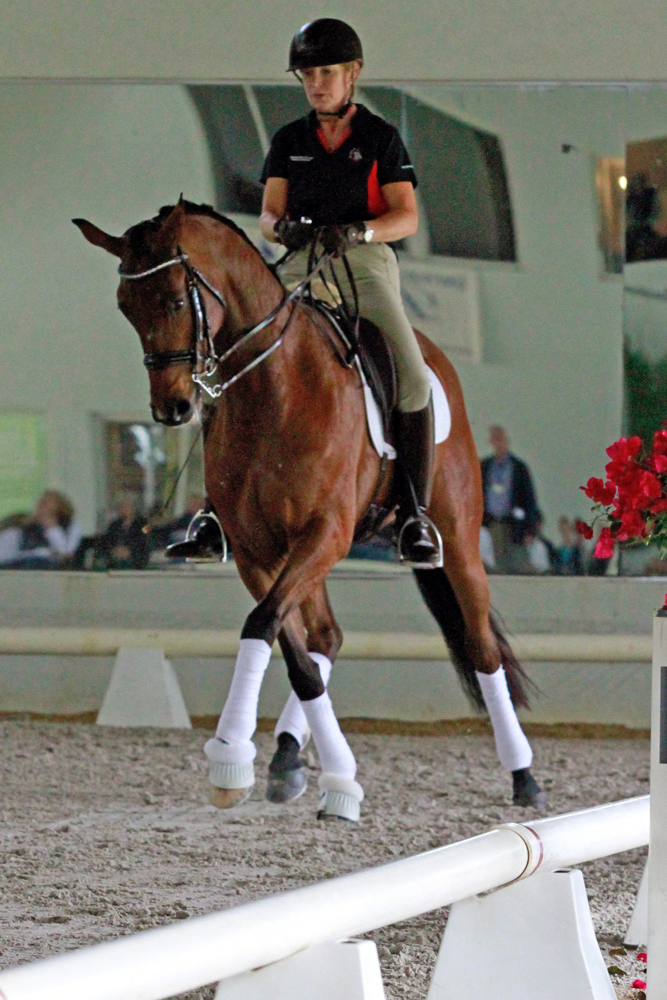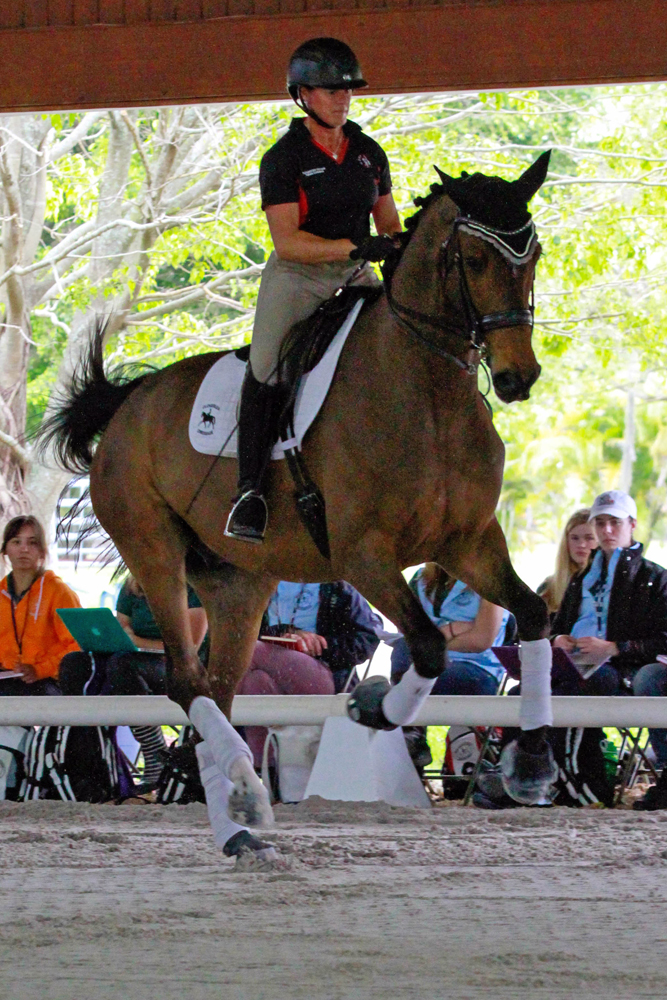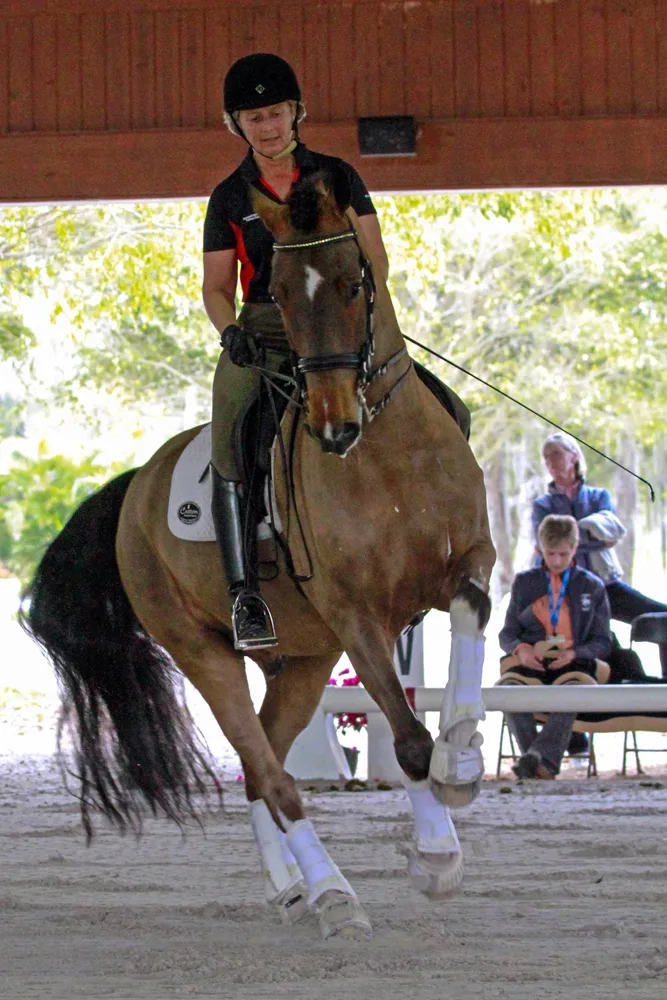Loxahatchee, Fla.—Jan. 20
Annie Morris took to the arena on the second day of the 2015 Succeed/USDF Trainers Conference and FEI Judge General Stephen Clarke complimented her on her horse’s sound training, citing a checklist of things the pair did right: the horse was in front of the leg, through his back and into the contact.
But now it was time to test the horse’s honesty. Although the 6-year-old Danish Warmblood gelding owned by Denise Sarnoff, Julia’s Magic, had no prior arrests, Clarke tested the pair’s work on walk/trot transitions to make sure the horse heeded Morris’ lower leg.
After passing the lie-detector test, the horse went to the next step: cantering while Morris thought about an invisible shoulder-fore position, controlling with the outside aids while activating and suppling with the inside aids. Once, again, Julia’s Magic didn’t hide from the contact and was pronounced “not guilty.”
“This is a horse I would kill to have,” Clarke said, seemingly ready to commit a felony for the gelding.
They checked the canter/trot transitions as the first of eight horse and rider teams riding at Mary Anne McPhail’s High Meadow Farm. The goal was to see if the horse could swing over his back and step into the contact.
“The canter/trot transitions are one of the few places the rider should wait for the horse,” Clarke said. “Wait for the trot to happen. As soon as the trot happens, you push the horse forward into the canter. “
Then he told Morris to play with the trot, varying bigger steps and smaller steps, all the while maintaining energy without speed. Clarke was impressed with the gelding’s ability to maintain the tempo while changing the trot.
“He’s like a concertina,” he said, thus kicking off Day 2 of the clinic with “Concertina Training.”
The next in was Lisa Pierson. After praising her on Baryshnikov’s confidence, suppleness in the bend and expressive changes, Clarke chose to work on the horse’s reluctance to accept the contact. Pierson and the 14-year-old Hackney gelding owned by Leeda Fletcher were instructed to perform just a few steps of passage, then back off to see if the gelding would continue in the passage.
“Say, ‘Here. Help yourself, boy. Carry yourself,’” Clarke advised.
He directed Pierson to keep her hands as still as possible in the trot to allow the horse to seek the contact and told her to organize herself so she could leave the contact alone when he did. Next, the pair worked on the canter and Baryshnikov had to nearly canter on the spot and then move forward.
When he succeeded, Clarke asked, “He has a little halo around his head doesn’t he?”
Clarke instructed Pierson to allow the little angel to rest while explaining the best way to give a horse a break after collection.
“Stretch and elongate both physically and mentally,” he said. “Walking, walking, walking on the long rein. Always stretch until he is through, properly relaxed and accepting good contact.”
ADVERTISEMENT
Male Model
Clarke was ready for the next one as Claire McNulty warmed up. As he turned his attention to the horse, he said, “Let’s see how Mr. Good-Looking is doing today.”
After commenting that Reel Adventure, a 14-year-old Hanoverian gelding owned by Dr, Kristy Lund, seemed very pleased with himself, Clarke added that the gelding is a very clever horse and McNulty must outsmart him and take charge. He admonishing her to give him a nudge to go forward and when she administered a subtle aid, Clarke teased her.
“That wasn’t a whack, that was a tickle,” he said. “We want him to travel along so you don’t actually need your legs.”
She was to give her aids with conviction and then “sit there like a church mouse, still and deadly effective.”

Claire McNulty worked on giving clear aids to Reel Adventure, aka Mr. Good-Looking.
He had her make a game of pushing the horse forward and then bringing him back, then pushing him forward again, never allowing the horse to be certain if he will soon need to surge forward.
The Concertina Training game was on.
When Shelly Francis entered the arena with Patricia Stempel’s 10-year-old Hanoverian gelding Danilo and performed the Grand Prix Special, Clarke said their pirouettes were some of the best he had seen in a long time and awarded them a perfect 10.
Despite being told it was a privilege to watch Francis and Danilo work, the duo also had to play the Concertina Training game, although this time, it was regular trot steps to passage to trot again.
Finding Different Gears
After lunch, Clarke addressed D’Re Stergios and her own Sarumba, calling the 8-year-old Hanoverian mare, “The Wonder Horse.”
 |
|
D’re Stergios worked on perfecting the half-pass |
Clarke had the pair focus on the trot as preparation for the half-pass. As they moved forward in the working trot, he cautioned the rider to take care and not overdo while remaining relaxed as possible, since too much contact disturbed the sensitive mare. They were directed to make a circle and then a half-pass from V to M, first doing a shoulder-in while making sure the nose, neck and shoulder lead from V and remained aimed at M. He asked for a quality trot while once again requesting the Concertina Training and reminding her that the tempo of the trot should remain the same throughout the exercise whether asking for collection or extension. The mare began to get tense and Clarke cautioned the rider.
ADVERTISEMENT
“If she gets tense when trying new things, stay totally relaxed and confident,” he said.
Jennifer Baumert and Ramiro once again performed the Developing Horse Prix St. Georges and Clarke said he was impressed with the 8-year-old Dutch Warmblood gelding’s lateral movement and his willingness to cooperate.
They worked on the canter/trot transitions and, once again, the horse was asked to make the transition and then surge forward.
 |
|
Jennifer Baumert had Ramiro surge forward |
Christina Vinios was challenged to ask for more reaction from her 9-year-old Oldenburg mare Donna Carina 6, so she could obtain and influence the reaction, but on her terms. They started on simple transitions while pushing the mare up into the bridle and taking the contact forward. Clarke said the mare has great rhythm and proclaimed her “The Queen of Rhythm” as he invited the rider to push into the rhythm while still getting a light and electric reaction.
He asked the pair to leg-yield and explained how he uses the exercise in a variety of ways. He asks the horse and rider to take the quarter line and then leg-yield back to the track. He asks for the horse to have its nose to the wall and then leg-yield away from the wall, but his favorite is the leg-yield on a diagonal line.
“The main thing with a leg-yield is we don’t want a bend in the horse,” he said. “Only a little tiny flexion.”
Once again, he asked the rider to “play with the gears” and make the mare move forward in an uphill canter into the bridle with engaged hind legs, all without the help of the rider. They played with huge pirouettes as they quickened the pace, then let the mare settle into a free, relaxed and loose canter.
“You should be able to drop the inside rein at any moment because you made her honest to your inside rein,” Clarke said, referring once again to the lie detector test.
Noel Williams was commended for her improved Grand Prix test from the previous day on Sir Velos, an 8-year-old Westfalen gelding owned by Melissa Mulchahey. He challenged Williams to be very straight in the canter to get exceptional changes, and if the horse did not rise to the occasion, she should wait until he did.
“Be quite brave,” he said as he prodded her to move forward on the gelding. “I don’t care if it goes to hell in a hand basket.”
When Williams maintained the straightness for effortless changes on the long side, she grinned but the horse took the chance to lose his concentration.
“Don’t let him look around,” Clarke cautioned.
Throughout the clinic, Clarke remained ever diligent to not overtax the horses and had their best interests at heart. To that end, he talked about not starting a horse in a double bridle until the horse is established in a basic way of going and understands lateral work and is truly accepting. He discussed cross-training and told the audience he doesn’t treat horses like hothouse plants. He turns them out a couple of hours every day, if possible, and hacks them out in the woods to keep them fresh, yet fit and strong enough to do their jobs while ever mindful that they are horses. And he reminded the audience that no one asked him about rollkur, the controversial hyperflexion of the horse’s neck, a practice banned by FEI.
“I hate, it, I hate it, I hate it,” he said. “I understand it, but I hate it.”
Read all about Day 1 of the Succeed/USDF FEI-Level Trainers Conference.















